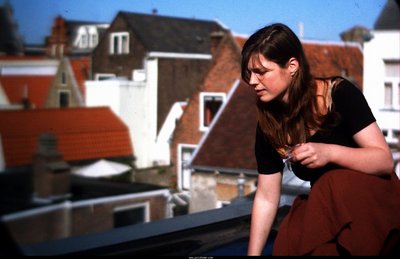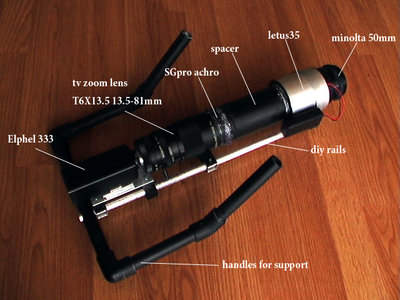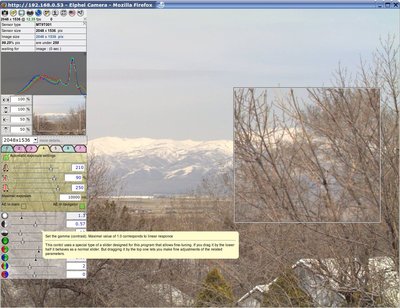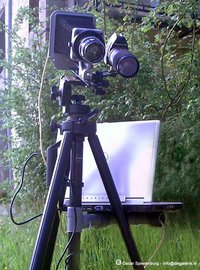Difference between revisions of "Apertus.Home"
Revision as of 10:49, 30 May 2007 (view source) Matteo pozzi (talk | contribs) (→MOVIES) ← Older edit |
Revision as of 00:46, 1 June 2007 (view source) Matteo pozzi (talk | contribs) (→info about elphel 333) Newer edit → |
||
| Line 33: | Line 33: | ||
<center>[[Image:333 hd setup.jpg|400px|abc]]</center> | <center>[[Image:333 hd setup.jpg|400px|abc]]</center> | ||
| + | |||
| + | and good example of what this setup could do: | ||
| + | [[Image:DLmoviegrab1.jpg|300px|abc]] <center>[[Image:DLmoviegrab1.jpg|300px|abc]]</center> | ||
==MOVIES== | ==MOVIES== | ||
Revision as of 00:46, 1 June 2007
Contents
Background
Hi to all! In this page we will discuss the possibility of the use of the elphel 333 and the next model camera as a CINEMA CAMERA, to make , at a low cost what was impossible some time (year/month)ago. Are we talking about a revolution? Maybe, or maybe we are only dreamers, but it's cool to be a dreamer with a revolution in mind! :-) That idea started in the first part of 2006 in the mind of a member of the dvinfo forum, and in March 26th 2006 01:46 AM, FS (I don't use the real name for privacy... FS if you want you can edit the page) started a new thread called High Definition with Elphel model 333 camera. Around one year later that thread has more than 400 responses, so searching through them to find good information can be difficult.
This page was born to try to solve that problem. Andrey said to us: "We need to organize data more like FAQ - thread is so big." so here we are.
Please excuse not-so-good English, it's not my own language, so feel free to fix the errors if you see them.
--Matteo.Pozzi -- Italy, 4 February 2007
PRESENT
info about elphel 333
Here are some important links to understand what we have already.
- model 333 general specification
- how the camera works article AJAX, LAMP, and liveDVD for a Linux-based camera on linuxdevices.com
- all the software that you need to use the camera sourceforge.net
- the link to Axis developer's site
- some video and images from the camera on elphel's community videos, on elphel.com, on tacx-video.com and a video by PS, the first image taken from FS with not the best conditions, a low ligth 35mm adapter test and one significant test example of dof from OS

- Example of a cinema camera setup by (D.L) ...and some result with it text test, Bottle D.o.f. test

and good example of what this setup could do:


MOVIES
- May 18th, 2007, 09:28 PM - first short made with the elphel 333 hd camera + 35mm wax adapter by O.S. using that setup:
The autor said:
"Here is a small version of the 'documentary' I made in France. While my girlfriend was working all day in the garden making a path.... I was testing all aspects of the Elphel. Yes, between some shots I helped her a bit, but filmmaking comes first, right?
This short film also proves you can synch a separate audio recording, using the old method with a clap board (in this case I just clapped my hands and said the take number, the same as the Elphel output filename) I used a portable minidisc recorder and it really worked fine. I also used the wax adapter (which really needs to be rebuild to get rid of soft edges), and a 'big' Panasonic TV lens (notice some telephoto close ups of the flowers).
The clip is reduced by half in resolution to upload, and is just a rough cut without color adjustments and some faults in the editing. I'll probably upload the final version at normal resolution of 1600x900 pixels and less compression. I'll post some stills at full size soon.
You can download the (54MB) file here: http://community.elphel.com/videos/RomainSurMeuse2.avi (it's in Xvid compression)"
or the full resolution version Xvid (200MB): http://community.elphel.com/videos/RomainFULL.avi
FUTURE
the new camera board by elphel (353) will have better specs then the 333 here are a fast FAQ that Andrey reply on the dvinfo forum (when I'll have time I'll edit in a better way)
To better understand how the new hardwere work look at this article on linuxdevices.com: High Resolution Cameras for Web Developers
1. What sensor will be available for the 353 at first release?
2. When will it be possible to buy the 353 + that sensor? (I dont mind being a beta tester with all it means)
I hope - early April
3. With the first release, will it be possible to record video to a hard drive connected directly to the IDE connector? (or will it require custom 353 hardware programming not available at first release?)
We do not have any adapters to actually connect the HD. We also do not have a camera body that will have room for one, that will come later. As well as the software fro recording - but it can be really simple to write on a disk from the software point of view.
4. What format will the recorded data have?
Same as camera can provide. Will start with MJPEG and I will restore Ogg Theora (ETRAX FS should be enough to handle some processing needed). All over formats - recode on a PC.
5. What frame rate / image sizes can be selected? (..or just tell me the sensor name and possible 353 restrictions)
Originally it will be up to (125/3) MPix/sec - the current FPGA code fro 333 can do that. Then - increase to have full speed of MT9P001
6. If it needs custom programming, where do I find info about tools / language etc? Just need a pointer. Any free compilers?
To be able to do development for these cameras you do not need any expensive (or even non-free-as-in-beer) tools. There are 3 levels (not to count client/PC software) 1 - "Web design" - developing of custom user interface - just any web design tools - you can FTP results to the camera 2 - Software applications to run in the camera - you need a PC running GNU/Linux (any flavor) and software from our Sourceforge project page plus additional - from http://developer.axis.com - our software will tell you what to download. 3 - FPGa code development - free (for download) tools from Xilinx - http://www.xilinx.com/ise/logic_design_prod/webpack.htm
7. Will the camera casing have space to accommodate a small hard drive?
It should have - in the future :-)
8. Any idea of power requirements?
Model 333 needs a little under 3W. 353 will need about the same - not to count additional modules - hard drive or flash.
9. Will the camera have a C mount?
CS-mount as it is more universal for cameras - you can install both C and CS lenses
10. If I use a simple SLR mount (Nikon or Canon) to C mount adapter (instead of a ground glass solution), what lens multiplier would be in effect?
That depends on particular sensor that will be used - each sensor usually has info on the Internet. And, BTW - we'll probably have control for EOS - at least we do now have it for our large cameras
11. Any idea what the sensor and 353 will cost?
I hope it will be about the same as 333.
Work In Progress
FPGA
Reading the dvinfo thread you can find someone (Z.H.) that is making some mod. to the current Fpga;
25 may 2007 - this project by Z.H. is in stand-by and he offer up his project for somebody else to take it over.
"If somebody's interested, here's the BloodSimple(TM) codec I wrote and experimented with. It creates a bitstream directly from the bayer input, always taking the difference of pixels as input. It works best if we use the algorithm in interframe mode, which means that we calculate the difference of pixels from the same coordinate of the previous frame. This of course needs that whole frame in memory.
An output sample always begins with a one bit flag (F) which tells the decoder if the following sample has the same bit length (F=0) as the previous one (a length of P) or it is greater with G bits (F=1). This G constant can be set according to the input stream and it will tell the contrast ratio of the generated images: with a T bit input, following pixels usually don't have more difference than T/2 bits. Visually lossless is around T/3 but it can be calculated explicitly in a pre-encoding step if needed. (By having the motion blur of the 1/24sec exposure, the blur caused by fast pans won't cause quality loss in the encoder as it would do with shorter exposure times.) If F=0, the decoder uses the previous P bit length but if the sample's most significant L bits are zero then the next sample will be taken with P-L bits (if that sample's F=0). The encoder knows this and if the next sample's length is greater than P-L then it sets F=1. L is usually set to T/4.
With sample videos (no real bayer input, only some grayscale mjpeg stuff with some artifical noise added) it has produced a 2:1 average ratio which means 2.5:1 with low freq content and 1.5:1 with high freq content (ie. trees with leaves with the sky as background). Because the code is so simple one can use several module instances in an fpga, for example, one for each pixel in a 20x20 block (or whatever the Elphel uses), working in paralell with only the memory bandwith setting the performance limits. However, with a smaller no. of instances it may fit beside the theora module; altough two output streams aren't supported yet. And it's really easy to implement it in verilog which can be a concern if somebody's not an expert"
"I'm afraid there are no verilog programmers here but somebody might pick it up. As for other bayer cameras, I'm not aware of any other which could be freely programmed like the Elphel. And the compression rate is pretty low (just enough for the Elphel, hopefully), perhaps it might be combined with some other algorithm to get better results."
Graphic User Interface (GUI)
For now we have a very good interface with the possibility of modify every single parameter that you can imagine, it is the ccam.cgi that may be get confusion (being incrementally patched from the first model 303 camera), but it is current.

But for converting the elphel in a cinema camera that freedom is more than enough. Also there are some problems; the software and LiveCD give some difficulty, in fact you can't save the setting in an easy way so to prepare the laptop end the camera you have to spend between 10 to 20 minutes to setup all the command lines that had to be entered to optimize Linux for recording, and more command lines to record etc.
If you want to help us please see this page link

